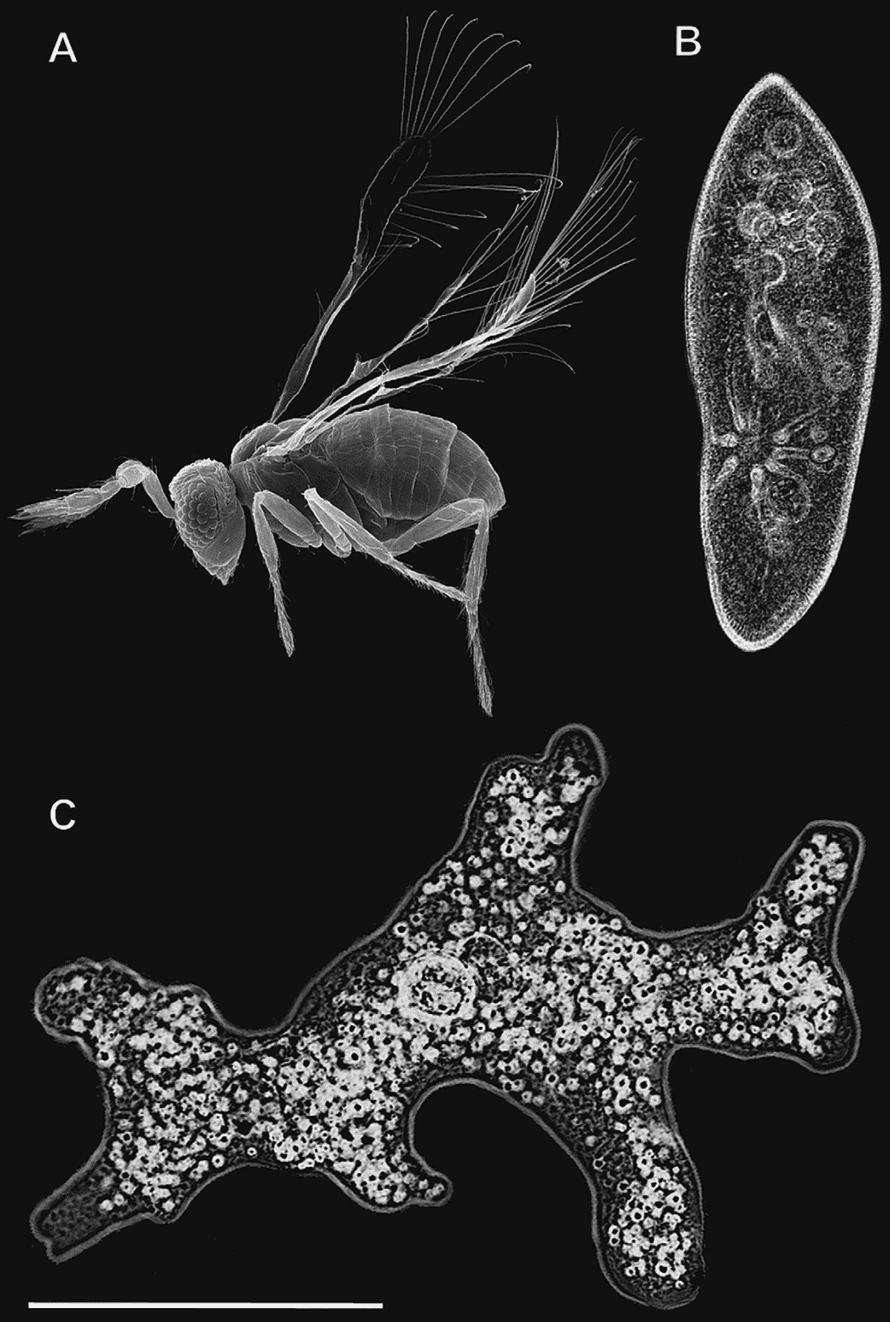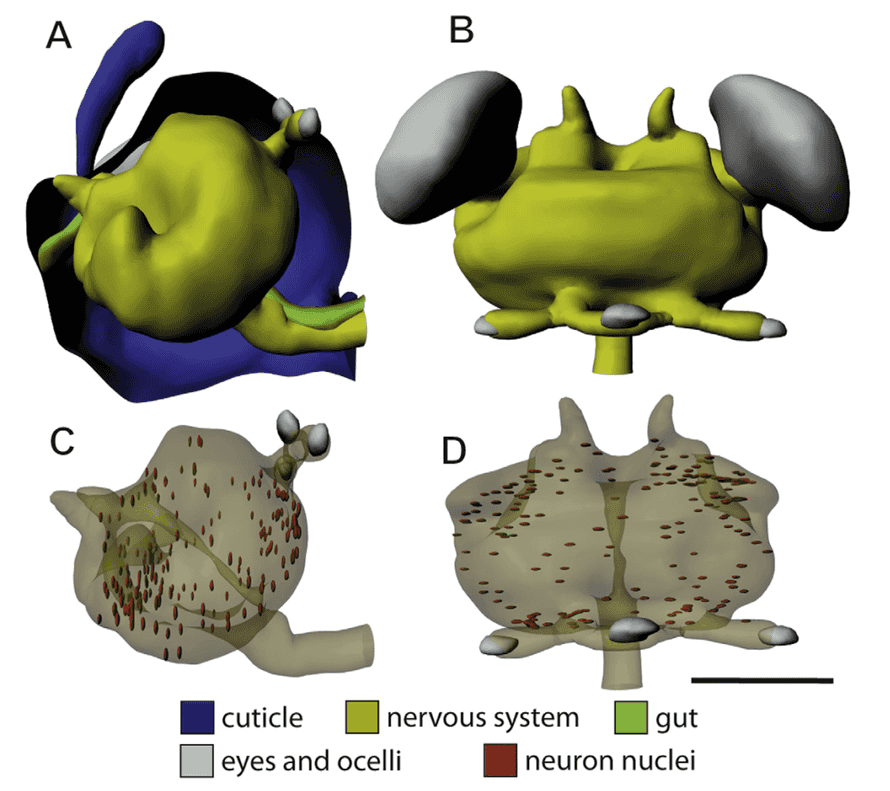[This post is part of an ongoing challenge to understand 52 papers in 52 weeks. You can read previous entries, here, or subscribe to get notified of new posts by email]
There is a species of parasitic wasp smaller than an amoeba or a paramecium. Imagine that, a whole wasp smaller than some single cell organisms. Sure amoebas and parameciums are some of the biggest single cell organisms, but that's still amazing.
Alexey A. Polilov's The Smallest Insects Evolve Anucleate Neurons talks about one of the adaptations Megaphragma mymaripenne evolved to become the tiniest flying animal in existence.

Miniaturization
Vertebrates achieve miniaturization by changing their skeleton and organ size, but invertebrates get into some real trouble because when tiny insects become even tinier there just isn't a lot of space left. In particular, the nervous system isn't something that can just magically become smaller.
Some species of microscopic ants move parts of their brain out of the head and into other parts of the body. This happens during the pupa stage of metamorphosis - between the larva and an adult animal. In butterflies this would be the cocoon, which comes between the caterpillar and butterfly stages.
But wasps have very articulate heads and there isn't enough room in their neck to have a multi-part brain. This causes problems at the cellular level and means they have to do something pretty amazing.
Most of the neurons lose their nucleus.
Research
The researchers compared pupa and adult stages of two closely related microscopic wasps - the Megaphragma mymaripenne and the larger Trichogramma evanescens. Specimens were fixed in formaldehyde and sliced into 1µm slices.
Using these slices they created 3D models of the specimens, which helped them calculate volumes of different tissues. Later on the slices were coated in gold so they could be looked at under an electronic microscope.
The research and methodology section isn't very interesting in general, but the detailed info on software and equipment used might help you reproduce the experiment. You know, because you have that Jeol JEM-1011 microscope just lying around and don't know what to do with it.
Results

Megaphragma mymaripenne's nervous system undergoes a significant change during the pupa stage. Much greater than other insects.
Most of the ganglia merge to form single ganglia for specific parts of the body. The abdominal ganglia merge into a single one and so on. This saves a lot of space, but that pesky brain occupies most of the head.
That's why 95% of neurons also undergo lysis, which basically means parts of the cells disintegrate. In this case, they lose the nucleus so the adult wasp has only 339 to 372 nuclei in its whole nervous system, 179-253 of which are in the brain. Compared to normal wasps' 37,000 nucleated neurons that's not a lot.
In fact, 2.9% of this tiny wasp's volume is taken up by the nervous system. Considering normal insect brains take up only 0.35% to 1.02% of the owner's volume you can say something really special is going on here.
The discussion section mentions this wasp might have hit the lowest possible size limit for an animal with a nervous system. Reducing size further would introduce problems on the chromosome level, and would have to include removing whole neurons.
Which is apparently something that doesn't just happen. According to volume calculations the adult M. mymaripenne has got the same number of neurons as the pupa stage, but makes them smaller with the nucleus trick.
Interestingly, the M. mymaripenne is completely typical during the pupa stage. Not only does it have the normal number of neurons, even their volume percentage is typical - 19%.

Better still, the M. mymaripenne retains all functions you'd expect from an adult wasp. Despite the low number of nucleotal neurons it can still fly around, find hosts, and lead a normal life for the five days it's supposed to live. Pretty amazing if you ask me.
One thing I didn't find in the paper is the exact significance of neurons without nuclei, it was assumed readers understand that much of biology. From what I could gather elsewhere, the nucleus contains cell DNA and regulates gene expression, which tells the cell what to do. So I'm guessing all those anucleate neurons aren't doing much to help the wasp's life.
But there you have it, the animal that needs the least brain power to fly. Amazing.

Continue reading about Week 4: Tiny insects evolve anuclear neurons
Semantically similar articles hand-picked by GPT-4
- Week 13, constructing logic circuits in mammalian cells
- Week 9: Life at low Reynold's number
- Science Wednesday: Self-driving cars
- Atoms, molecules, organisms
- Viri have it hard
Learned something new?
Read more Software Engineering Lessons from Production
I write articles with real insight into the career and skills of a modern software engineer. "Raw and honest from the heart!" as one reader described them. Fueled by lessons learned over 20 years of building production code for side-projects, small businesses, and hyper growth startups. Both successful and not.
Subscribe below 👇
Software Engineering Lessons from Production
Join Swizec's Newsletter and get insightful emails 💌 on mindsets, tactics, and technical skills for your career. Real lessons from building production software. No bullshit.
"Man, love your simple writing! Yours is the only newsletter I open and only blog that I give a fuck to read & scroll till the end. And wow always take away lessons with me. Inspiring! And very relatable. 👌"
Have a burning question that you think I can answer? Hit me up on twitter and I'll do my best.
Who am I and who do I help? I'm Swizec Teller and I turn coders into engineers with "Raw and honest from the heart!" writing. No bullshit. Real insights into the career and skills of a modern software engineer.
Want to become a true senior engineer? Take ownership, have autonomy, and be a force multiplier on your team. The Senior Engineer Mindset ebook can help 👉 swizec.com/senior-mindset. These are the shifts in mindset that unlocked my career.
Curious about Serverless and the modern backend? Check out Serverless Handbook, for frontend engineers 👉 ServerlessHandbook.dev
Want to Stop copy pasting D3 examples and create data visualizations of your own? Learn how to build scalable dataviz React components your whole team can understand with React for Data Visualization
Want to get my best emails on JavaScript, React, Serverless, Fullstack Web, or Indie Hacking? Check out swizec.com/collections
Did someone amazing share this letter with you? Wonderful! You can sign up for my weekly letters for software engineers on their path to greatness, here: swizec.com/blog
Want to brush up on your modern JavaScript syntax? Check out my interactive cheatsheet: es6cheatsheet.com
By the way, just in case no one has told you it yet today: I love and appreciate you for who you are ❤️
